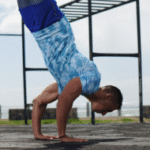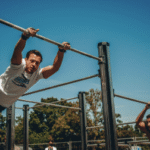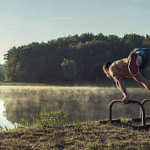What to Expect in a Handstand Class: A Beginner’s Guide
The idea of learning to balance on your hands is a powerful one, and in a city like Houston, with its dynamic fitness culture, dedicated handstand classes are becoming an increasingly popular way to build strength, control, and confidence. But what actually happens when you walk into one of these classes for the first time?
It’s not about being thrown upside down and told to “balance.” A quality handstand class is a structured, scientific, and surprisingly safe environment designed to build your skills from the ground up. This guide will walk you through every phase of a typical beginner’s class, so you know exactly what to expect on your journey to defying gravity.
Phase 1: The Foundation – The First 15-20 Minutes
The class doesn’t start with kicking up; it starts with preparing your body for the work ahead. This is arguably the most important part of the session for long-term, injury-free progress.
The Warm-Up: Expect a general warm-up to get your blood flowing, followed by a series of movements specifically designed to prepare the joints that will be under the most stress.
Wrist “Bulletproofing”: This is non-negotiable. You will spend several minutes on your hands and knees doing a variety of drills like wrist circles , finger pulses , and gentle wrist stretches . This is crucial for building the strength and mobility needed to prevent the most common handstand-related injury.
Shoulder Activation: You’ll move on to drills that “wake up” your shoulder girdle. This includes exercises like scapular push-ups (moving only your shoulder blades), cat-cows , and shoulder circles to ensure your shoulders are stable and ready to support you.
Phase 2: The Engine Room – The Next 15-20 Minutes
This is the strength-building portion of the class. A handstand is a skill of strength before it’s a skill of balance. You will work on the specific muscles that create a strong, straight line.
Core Conditioning: A handstand is a “plank in the air.” Expect to spend significant time on core-compressing exercises. The hollow body hold is the king of all handstand conditioning drills, and you will practice it extensively.
Shoulder Strength: You will work on exercises that build the specific strength needed to push the ground away. This typically includes pike push-ups (with feet on the floor or a box) and various plank holds .
Body Line Drills: You’ll practice creating a perfectly straight line with your body while lying on the floor. This builds the muscle memory needed for when you’re upside down.
Phase 3: The Skill Work – The Final 20-25 Minutes
Now it’s time to go upside down, but in a completely safe and controlled way.
The Wall is Your Best Friend: As a beginner, you will not be expected to balance in the middle of the room. The wall is your primary training tool. You will learn how to do a chest-to-wall handstand , which is the safest and most effective way to build endurance and learn proper body alignment.
Learning to Fall (The Safety Net): Before you even kick up, a good instructor will teach you how to safely bail out of a handstand. The most common method is a simple cartwheel exit . You will practice this from low-impact positions until it feels natural. Knowing you can fall safely is the key to removing fear.
Drills, Not Just Holds: You won’t just stand against the wall. The instructor will guide you through specific drills while you’re in a wall-supported handstand. This might include shoulder taps (lifting one hand to tap the opposite shoulder) or heel pulls and toe pulls (learning to find your balance point by gently moving your feet away from the wall).
Expert Spotting: For any new or challenging movement, the instructor will be there to physically spot you, providing support and real-time feedback to keep you safe and help you feel the correct position.
What to Expect Mentally and Physically
You Will Be Challenged: Your shoulders and core will be worked in ways they never have before. It’s normal to feel tired and maybe a little shaky.
It’s a Process, Not a Performance: A good handstand class has a supportive, non-judgmental atmosphere. Everyone in the room, including the instructor, was once a beginner. “Failing” (i.e., falling out of a hold safely) is a normal and expected part of the learning process.
You Will Feel Empowered: Even holding yourself against the wall for 30 seconds is a huge accomplishment. You will leave the class feeling stronger and more capable than when you walked in.
What to Wear and Bring
Wear comfortable, fitted athletic clothing that won’t ride up when you’re upside down. A t-shirt that can be tucked in or a fitted tank top is ideal.
Bring a water bottle. You will sweat.
Come with an open mind and a willingness to be a beginner.
Conclusion:
A handstand class is a journey into the art of body control. It’s a methodical, safe, and incredibly rewarding process. You can expect a session that is heavily focused on building a strong and resilient foundation, with a gradual and intelligent progression towards the skill itself. For anyone in Houston looking for a new and empowering fitness challenge, it’s an experience that builds you from the ground up.

What to Expect in a Handstand Class: A Beginner’s Guide
Route
Calisthenics Gym Houston Functional Bodyweight Training
Secondary phone: (346) 483-3195
Email: info@calisthenicsclubhouston.com
URL: https://calisthenicsclubhouston.com/
Monday 6:00 AM - 7:00 PM Tuesday 6:00 AM - 7:00 PM Open now Wednesday 6:00 AM - 7:00 PM Thursday 6:00 AM - 7:00 PM Friday 12:00 PM - 6:30 PM Saturday 9:45 AM - 12:00 PM Sunday 3:00 PM - 5:00 PM





